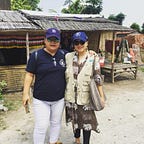“I knew it would be a challenge, but I was determined to do my part”
The Rohingya exodus happened on my birthday and the lives of a million people changed forever. Sadaqat Omar shares his story and what he’s doing to help.
On the 25th of August 2017, while I was celebrating my fourteenth birthday with my family, the lives of almost a million Rohingya just across the border from my home was destined to change forever.
On my way home from dinner, I was going through my Instagram feed and I saw the headlines that caught my attention — “Thousands of Rohingya entering Bangladesh.” I read the article and was horrified and couldn’t believe what was going on in Myanmar.
My night was rather sleepless as I couldn’t get the vile images of children of my age and even younger fleeing their homes and being tortured, women who had survived rape, and other brutalities which were beyond my imagination.
The next day I got up really early and could not stop thinking about the Rohingya crisis. I felt very helpless as they had to leave everything they possessed and flee for their lives. I spent the morning trying to figure out how I should contain my emotions and figure out a way to help this community.
I spoke to my friends from school about how we should help the Rohingya and we concluded that at first, they would need the basics — food, water, sanitary products after walking/swimming for two days. I knew it would be a challenge to raise a large sum of money, but I was extremely determined to do my part to help them.
Raising money for a cause
I approached my School Principal and the Superintendent of the American International School in Dhaka (AISD) and asked them for some advice. I got their permission to make posters to ask for help and these were circulated around the school and printed in the morning bulletin.
The message highlighted the dire situation of the Rohingya to everyone and urged them to donate USD 11 each to purchase basic items. I also reached out to several private companies such as Partex and Unilever and requested them to donate food and sanitation products. In less than a week, we were able to raise USD 34,000 in cash and USD 6,000 worth of food items. The alumni and students of AISD supported this cause with their big hearts.
The first round of the response
On September 2017, I went with AISD’s Superintendent Mr. Stephen Herrera and Principal Mr. Robert Doyle to Unchiprang Rohingya Refugee Camp and distributed food, water, and hygiene products.
This was the first time I had ever witnessed human suffering on such a large scale and interacted with refugees. I was overwhelmed and devastated by all the agony and pain that people were living with. I was shattered to see children, mostly orphans trying to survive on their own and see some of them carry sacks of food and water twice their size. This truly represented their resilience and will to survive.
There were ample funds left over from the initial fundraising initiative and I thought to myself so much more could be done. I wanted to ensure the leftover funds were used for a long-term project which could improve the lives of the Rohingya and wanted to tie up with a reliable organization working with them.
I believe in the work of the World Food Programme
This summer I had an opportunity to volunteer with the United Nations World Food Programme (WFP) in Dhaka. During my internship, I was able to visit the refugee camps two years after they had been living in Cox’s Bazar.
I was able to see the tremendous work carried out by WFP where they feed a million refugees each day. I also engaged with other WFP activities- school feeding, engineering, nutrition, e-voucher stores, and disaster management initiatives and was impressed by the impact they are making in the lives of these refugees. It was a quick and easy decision for me to contribute the remaining funds of USD 30,000 to WFP.
Helping Rohingya families to build new lives
The funds I contributed to WFP were utilized in two projects: Self-Reliance Program and the Aqua Farming Program.
The Self-Reliance Program provided adolescent girls and women with skills such as sewing, repairing and maintaining electronics, and other livelihood opportunities that would make them financially independent in the coming days.
As the daily diet of the refugees consists of very little protein, the Aqua Farming project support refugees so they can consume fish from the pond. This makes their diet more diverse and nutritious and who doesn’t deserve a healthier diet?
My call to action
While I was able to raise $30,000 for the Rohingya refugees, I would request everyone to support in raising funds for the host communities who have been so generous in welcoming the refugees to their community.
Want to make a difference? Make a donation to support WFP’s Rohingya response.
Story written by Sadaqat Omar
